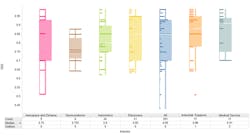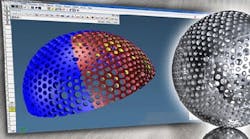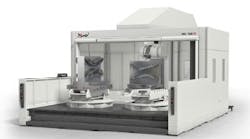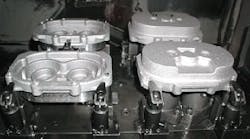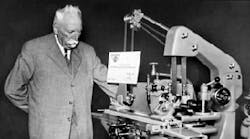Industry executives address issues and trends in the tooling industry.
Company leaders comment on dry machining and changes in tooling and new coating technology.
Readers had many questions about dry machining technology. What is being done to make tooling last longer without using coolant?
Fred Teeter
Marketing Manager Balzers Tool Coating Inc.
Although less work is done in the U.S. in the area of semi-dry or dry machining than in Europe, it is a major trend that will be driven by cost and environmental concern issues.
Thin-film wear resistant coatings will play a major role in the success of this technology due to the ability of coatings to make up for the loss of lubricity and cooling effect from the reduction/elimination of metalworking fluids. The coating of choice for reduced lubricant machining is TiAlN (Titanium Aluminum Nitride); particularly multilayer coatings such as Balinit FUTURA. This coating has extreme hardness and high oxidation resistance. It acts as a good "Thermal Manager"—that is, it provides protection to the tool by effectively transferring the heat to the chip, leaving the tool and workpiece relatively unaffected by the heat. In addition, the relatively new technology of using a hard thin film, such as FUTURA, in combination with a softer carbon coating, such as Tungsten carbide/carbon is proving to be of great value in a variety of machining operations; particularly drilling and tapping.
Growing interest in the U.S. in machining dry or near-dry is directly related to the increasing costs of machining with flood coolant and all that goes with the purchase, processing, and disof coolants. posal
Cost reduction demands increase daily, and we are now in a position to offer technological answers to meet the challenge. This is achieved by combining new substrate materials, innovative tool geometries, and multi-layer coatings with particular emphasis on heat resistance and lubricity. Our MOVIC—a special soft coating process made from MoS2 and fourteen other additives—acts as a gliding agent between the cutting tool and the chips, greatly reducing the friction coefficient at the tool surface and avoiding edge buildup. MOVIC tools produce only about 1 /6 the friction of TiN-coated tools. The new multi-layer FIREX coating is a hard coating that combines TiN, TiCN, and TiAlN in distinct, alternating ultra-thin nano layers. This new universal multi-layer coating offers performance benefits far beyond those available with single-layer coatings alone. Typically, FIREX-coated tools perform two to three times better than TiN alone. This universal coating has greater heat resistance than TiAIN, high density and toughness, and a hardness exceeding 90 Rc.
Jeff Seliga
Advertising and Trade Show Manager Mitsubishi Machine Tools, MHI Machine Tool USA Inc.
As a key part of its revolutionary dry hob cutting system, a proprietary dry hobber has been developed by Mitsubishi engineers. The new process completely eliminates the need for cutting fluids and can reduce overall gear production costs by more than forty percent.
The super dry hob is a distinctive cutting tool made of MACH 7 material with a proprietary coating that dissipates heat and reduces tool wear. It allows a hobbing speed of two hundred meters per minute which is two times faster than conventional machining, with tool life up to five times that of a conventional hob.
Faster cycle times mean fewer machines are required—thereby reducing capital investment, labor hours, and floorspace needed. Longer tool life means users will need a smaller tool inventory, with less frequent tool changes or re-sharpening, and less overall machine downtime. The process is ideal for gears that range from automotive final drive gears and larger truck gears, to automotive pinion and sun gears.
Because production runs are getting shorter, several reader indicated that they wanted better general purpose inserts, rather than productive, but expensive, specialized inserts. How will tooling change to deal with the shorter production run?
Bob Maxey
Vice President of Engineering Precision Twist Drill Co.
The main driver of change— cost reduction through productivity gains—has created an evolution toward drill designs which contain new base tool materials, new geometries, tighter tolerances, and new generation coatings.
This evolution is having an impact on traditional high-speed steel product offerings by placing more focus on process cost reduction through higher throughput performance. More emphasis is now being geared toward the economic concepts of machining as well as environmentally compatible processes. This is because it is commonly accepted knowledge that tooling costs are a relatively minute percentage of total process cost.
Solid carbide, high-performance drills optimize drilling performance because of the following: Improved metallurgical properties of carbide raw material, special drill geometries, enhanced thin-film technology, CNC rigidity and accuracy, and high machine-tool cost.
Combinations of improvements in base-tool material and multilayer thin-film technology are at the heart of the foundation, and the "drivers of change" have created the catalyst for market acceptance. The current market will continue to grow as new machine-tool technology is populated into the manufacturing facilities. High-speed steel drills will not be totally replaced by solid carbide, but transformed into designs which are also very applicable in achieving cost reductions through productivity gains. Education and machining concept analysis will play heavily into tool selection between high speed and carbide product.
Coatings have made it possible for tools to cover a broad range of materials and cutting conditions. What other advances can we expect in the near term?
Keith H. Smith
Manager of Marketing and International Sales Greenleaf Corp.
I wish we could sit down at any time and predict advances, long or short term. If this were the case, then there would not be advances so much as improvements. Advances we hope will be breakthroughs and impact situations more dramatically.
Coatings are not over and done with in terms of improvements by a long shot, and we predict we will see many changes. Ceramic technology has made a strong impact but also has a long way to go in making inroads versus carbide. We can expect to see much more ceramic used in steel machining. Reinforced ceramic materials such as Greenleaf WG-300 have set the stage for considerable activity in reinforcement technology which will see near-term impact.
In the area of turning, further major developments in coatings are unlikely in the short term. What we can expect is small incremental steps, such as further refinement of the coating layers. Carboloy and other cutting-tool companies will also continue to micro-engineer the inter-face between the insert substrate and coating. That will provide better coating adherence and allow the tool to perform effectively in even more demanding applications.
In the area of PVD coatings, the promising new titanium-aluminum-nitride coatings should become more versatile as more is learned about increasing their aluminum content. On the milling side, the continuing trend will be toward complex multi-layer PVD coatings. A related development is the ability to direct press milling inserts, eliminating grinding operations. Other proprietary manufacturing processes have been developed by Carboloy for producing complex insert forms and geometries. All of these newer methods provide enhanced design flexibility and precision by eliminating most grinding operations.
The use of cryogenics is becoming more widely used to extend tool life and make cutting tools more wear resistant, stable, and durable. It has taken many years for the tooling industry to become aware of and educated about cryogenics. With editorials, testimonials, advertising, and feature articles, the machining industry is slowly becoming more aware of the cryogenic process and all of its benefits. Cryo treatment is a one-time permanent process unlike coatings that need to be reapplied after each sharpening. It can create a premium, more profitable tool and save a lot of tool expense dollars for end users.
Given all the new types of tooling on the market, what will be the parameters for a company to efficiently evaluate new cutting tools?
Alan Godfrey
Vice President of Marketing Sandvik Coromant Co.
Cost per part will continue to be the most important element in evaluating cutting tool performance. Though tooling represents a relatively small portion of total cost per part, i.e. about 2.5%, it can have significant impact on total cost per part. And the costs are usually more readily quantifiable versus some of the other cost drivers, which are sometimes subjective.
In a turning operation, for example, if cutting speed or feed are increased by 20%, machining cost will be reduced by a significant 15%. By contrast, improved tool life, though important, has less of an impact on cost per part than many believe. In a turning operation, a 50% increase in tool life will reduce cost per part only by 1%.
The overriding goal in a jobshop should be to increase cutting data whenever possible, and the criteria for evaluating a tool is how far it can be pushed to achieve the desired number of parts in a bin. More parts per hour in the bin will inevitably lead to lower machining and operating costs. Though machine shops are often very conservative in their machine settings, we always recommend increasing speeds and feeds once the tool has proven itself. In a jobshop environment, the best way to maximize productivity and get optimum tool life is to run edges for 15 minutes, then index.

